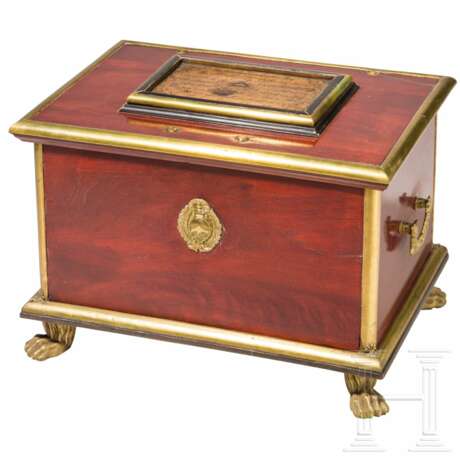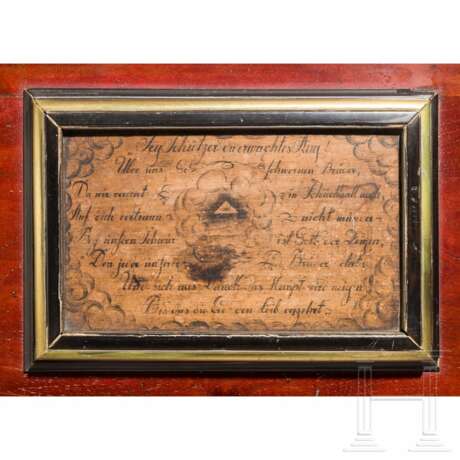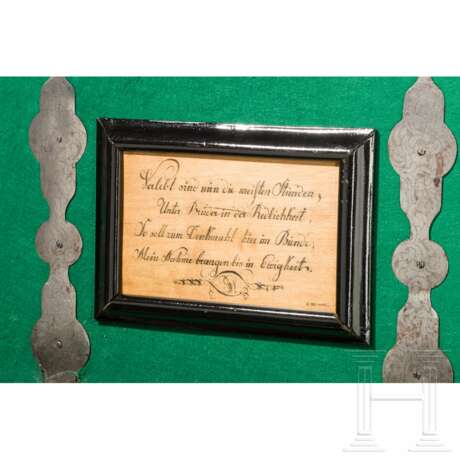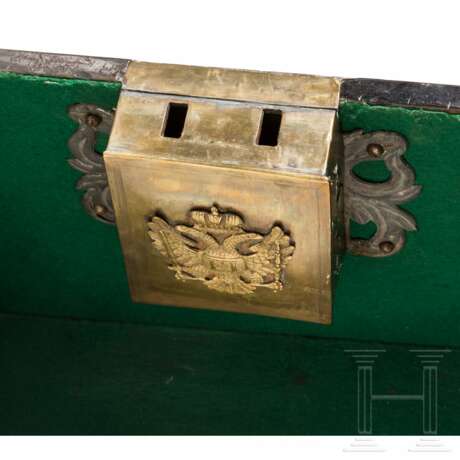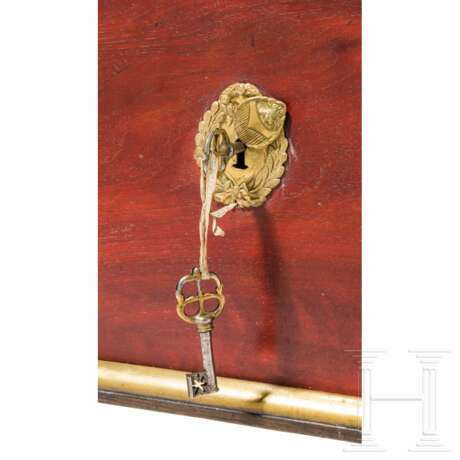ID 1416761
Lot 4409 | Truhe einer Freimaurerloge, Österreich, um 1790
Flache, goldfarben gefasste Sockelplatte auf vier fein ziselierten Löwenfüßen aus Messing. Der Korpus mit Mahagoni furniert. Vorderseitig reich reliefierter Schlüsselschild mit schwenkbarer Schlüssellochabdeckung. Seitlich bewegliche, reliefierte Tragegriffe aus Messing. Auf dem scharniergelagerten Deckel eine aufgelegte Kassette mit "allsehendem Auge" und Aufschrift "Sey Schützer erwachtes Aug! Über uns geschworne Brüder, auf eich vertraun nicht minder, Bey unserm Schwur ist Gott der Zeigen, den jeden unserer Brüder leit, und sich aus Demoth das Haupt wird neigen, bis das die ... den Leib vergehet". Auf der Innenseite des Deckels weitere Schrifttafel "Verlebt sind nun die meisten Stunden, unter Brüdern in der Redlichkeit, so soll zum Denkmahl hier im Bunde, mein Name brangen bis in Ewigkeit". Aufwändiges Kastenschloss mit Messingrahmen und reliefiertem, aufgelegtem Doppelkopfadler. Seltener Mechanismus, bei dem zwei Fallen mit separaten Schlüsseln durch ein Schlüsselloch geschlossen werden. Beide Fallen rasten beim Öffnen ein, und können mit seitlich am Schloss befindlichen Hebeln wieder ausgelöst werden. Voll funktionsfähig, die beiden originalen Hohldornschlüssel erhalten. Das Innere mit späterer Innenauskleidung mit grünem Filz. Die Bodenplatte herausnehmbar, darunter Einsatz mit fünf Geheimfächern. Maße 42 x 56 x 41 cm.
Ähnlich den Zünften verwahrten Logen ihre wichtigsten Papiere wie Mitgliederlisten, Logensiegel und Logenkasse in einer speziellen Lade. Nach dem Vieraugen-Prinzip wurden die Schlüssel von zwei verschiedenen Mitgliedern verwahrt, sodass nie ein Einzelner unbeaufsichtigt Zugriff auf den Inhalt hatte.
Die erste, 1742 gegründete Freimaurer Loge in Österreich wurde nach nur kurzem Bestehen auf Anordnung der Kaiserin Maria Theresia geschlossen. Zwischen 1754 und 1770 entstanden in Wien weitere Logen, wurden aber vom Staat weiter verfolgt, obwohl sie teils auch einflussreiche Mitglieder vom Wiener Hof hatten. Kaiser Joseph II. erließ 1785 das Freimauererpatent, dass die Tätigkeit der Logen reglementierte, aber auch legalisierte. 1795 wurden die Logen in Angesicht der französischen Revolution erneut verboten. Die hier angebotene Logentruhe stammt vermutlich aus der kurzen Blütezeit der österreichischen Freimaurer von 1785-95.
An Austrian chest from a freemasons' lodge, circa 1790
An Austrian chest from a freemasons' lodge, circa 1790
The flat base plate painted gold, standing on four finely chased lion's paws in brass. The chest veneered in mahogany. A raised escutcheon and sliding keyhole cover on the front. A movable carrying handle in brass with relief decoration on each side. A cartouche appliquéd on the hinged lid with an "all-seeing eye" and freemason's inscription (tr.): "Protect us, awakened eye! Above us, sworn brothers, in whom I trust equally, as God is our witness, we have sworn an oath that guides each of our brethren, and he shall bow his head in humility until such time as the body perishes...". A further inscribed plaque on the inside of the lid reads (tr.) "Most hours have now passed, among brothers in righteousness, so shall the memorial here in the lodge, commemorate my name until eternity". Elaborate box lock with a brass frame and appliquéd double-headed eagle in relief. Rare mechanism, in which two latches are closed with separate keys through a keyhole. Both latches engage when opened and can be released again by means of levers located on the side of the lock. Fully functional, both original hollow shank keys are included. The interior lined in green felt of later date. The base plate can be removed to reveal an insert with five secret compartments. Dimensions 42 x 56 x 41 cm.
Like the guilds, lodges kept their most important documents such as membership lists, lodge seals and lodge strongbox in a special drawer. According to the dual-control principle, the keys were kept by two different members, thereby ensuring that no individual had unattended access to the contents.
Founded in 1742, the first Masonic Lodge in Austria was closed down after only a short period on the orders of Empress Maria Theresia. Other lodges were established in Vienna between 1754 and 1770 but were persecuted by the state, although they also included influential members from the Viennese court. Kaiser Joseph II issued the imperial edict, "the Freemason Patent" in 1785, which regulated but also legalised the activity of the lodges. In 1795, the lodges were banned once again in view of the French Revolution. This lodge's chest probably dates from the short heyday of the Austrian Freemasons between 1785 and 1795.
Condition: II
| Auction house category: | Folk arts and crafts |
|---|
| Auction house category: | Folk arts and crafts |
|---|
| Address of auction |
Hermann Historica Bretonischer Ring 3 85630 Grasbrunn / München Germany | ||||||||||||||
|---|---|---|---|---|---|---|---|---|---|---|---|---|---|---|---|
| Preview | |||||||||||||||
| Phone | +49 (0)89 5472 649 0 | ||||||||||||||
| Fax | +49 (0)89 5472 64999 | ||||||||||||||
| Buyer Premium | 25 % | ||||||||||||||
| Conditions of purchase | Conditions of purchase | ||||||||||||||
| Business hours | Business hours
|



